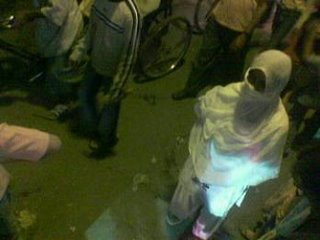published in http://khoj2006publicart.blogspot.in/
A version of this article was also published in the Art India Magazine
Report on the Delhi Burqa Projection Workshop (background to the performance)- The Delhi Burqa Projection workshop was conceived and led by Sophie Ernst, video artist and Assistant Professor, SVA, Beaconhouse National University, Lahore. She centered the performance on six young Muslim women students of Jamia Milia Islamia University (Nazia, Padma Renu Sonowal, Heena Yusuf, Sana Jafri, Bushra Hassan, Rukshana) who were the participants in the two-day workshop conducted. The workshop was centered on issues of ‘identity’, ‘stereotyping’, ‘absence’ and ‘spatial constraint’ in the context of young Muslim women, embracing, political and religious and aesthetic concerns.
A part of the process of the workshop was to make the participants shoot short videos, which were later, edited by Sophie. The process of the workshop itself included elements of drawing and certain other forms of communication like debates on ‘freedom’ for Muslim women in the public sphere and more specifically in public spaces, and ending with sessions on training the participants to video shoot and eventually leading up to the participants shooting short video footages.. Sophie later edited the video footages, and these footages became a key medium (as imagery to be projected) in Thursday’s performance. (I have not attended the...details picked up through fragmented conversations with the workshop coordinator)
Burqa projections at Turkman Gate Old Delhi: The event was framed, as a ‘Performance’ Students of Jamia Milia Islamia would be presenting their work done during workshop. After the workshop the Sophie along with the participants, choose a location for presentation. The goal was to present the work in a public space and open up the dialectics of the workshop to a wider audience. The sites chosen were lodged in the narrow lanes behind Turkuman Gate...a mosque outside Al Noor Hotel, and Chitli Gali. The young students presented six short video pieces, as they negotiated their way through the chaotic crowds and their unfamiliarity with equipment.
The participants took turns playing an actor, wearing a white burqa, walking through the space, while the one of them playing the operator would be tracing her movements with a video beam. The white burqua became the screen where the video clips where projected. The bright shaft of light coming from the projectors acted as a device which flattened the three dimensional volume of the actors transforming them into images on which the video clippings were super imposed.
However if one has to frame the Burqa projections at Turkman Gate as a Performance then it is imperative that one will intereogate the ‘performative’ aspect of the event and negotiate deeper into its contextual value. Sophie Ernst’s workshop and the Performance leading out of it, cannot be viewed in isolation and needs to be seen as a carry forward of a similar project she did with students of Beaconhouse National University, Lahore, leading to a ‘Performance’ at Delhi gate, Lahore. I have not witnessed the Lahore performance, but video footage of the ‘performance’ has been edited and presented by the Sophie as almost as an independent product. The video filters out the entire locational ambience and showcases the ‘walks’ in fleeting cuts (re) presenting the performers almost as if they are icons sleek and fleeting across a ramp.
Sophie lets her instincts of a video artist take over at two crucial junctures of the process...first as the editor of the video clippings shot by the participants, and most importantly as the agency who shoots and edits the final ‘performance’. As a video artist who exercises near complete agency over these two key areas (determining the look of the projections and determining how the ‘performance is re-presented), Sophie’s authorial instincts overtake the spirit of a workshop and cast it as an site of art production over which she exercises a dominant agency.
However, what I find most disturbing about Sophie Ernst’s intervention is the ideological formulations informing its foray into the ‘politics of representation’. The burqua has become a universal symbol of ‘the oppressed Muslim woman’; it has emerged as an easy trope enabling artists to comment on issues of Islamic patriarchy and repression of women in the public sphere. However, in both the Lahore and Delhi workshops, Sophie ‘casts’ college going young Muslim women, who do not wear burquas in their day-to-day lives and drapes them with burquas.
Though the act of projecting video footages developed in a workshop around issues of ‘identity’, ‘stereotyping’, ‘absence’ and ‘spatial constraint’ on the burqua, and acting it out in (Muslim) male dominated public space can be subversive, the subversive potential is undermined by Sophie predetermining the suppression in their lives and superimposing a outsider’s notion of ‘freedom’ onto them. Moreover at a formal level, the manner in which the bodies are reduced to a flat screen, which enacts a role predetermined by Sophie, allowing them to be completely objectified, very problematically raises the very questions of ‘identity’, ‘stereotyping’, ‘absence’ which the workshop and ‘performance’ were allegedly seeking to address.
It is true that certain ‘poetic’ moments emerged, that evening and the ‘performance’ did generate a lot of local curiosity. However the moments were nearly too fleeting to register, and the crowd that had gathered did not get to interact with either Sophie nor with the workshop participants, thereby weakening its impact as an intervention in the public sphere...in the sub continent it is way to easy to draw crowds, the real test is what one does with them.




